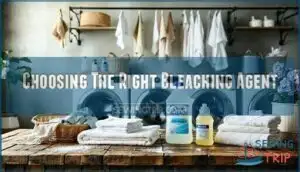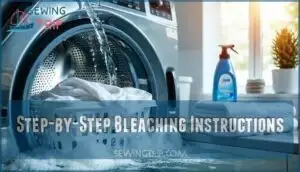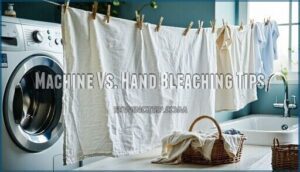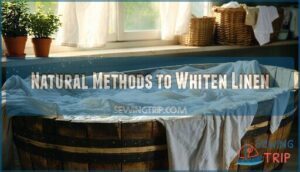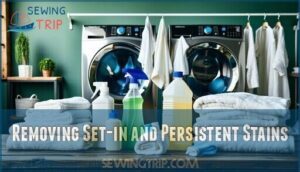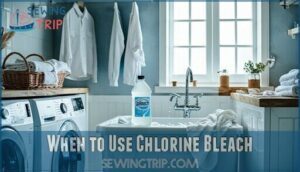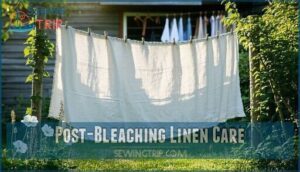This site is supported by our readers. We may earn a commission, at no cost to you, if you purchase through links.
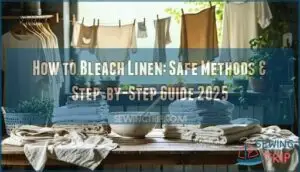 To learn how to bleach linen effectively, you’ll need to choose the right method for your fabric’s needs.
To learn how to bleach linen effectively, you’ll need to choose the right method for your fabric’s needs.
Start by checking care labels and performing a patch test with diluted bleach solution. For white linen, use chlorine bleach diluted 1:10 with hot water, monitoring every 15 minutes.
Colored linen responds better to oxygen bleach or natural alternatives like white vinegar soaks and sunlight bleaching.
Always pre-treat stains with enzyme cleaners and make certain proper ventilation during the process.
The key lies in understanding linen’s unique fiber structure and matching your approach accordingly.
Table Of Contents
Key Takeaways
- Test first, bleach second – Always perform a patch test on a hidden area with your diluted bleach solution and wait 15 minutes to check for damage before treating the entire piece.
- Match your method to your fabric – Use chlorine bleach (1:10 ratio with hot water) only on white linen, while colored linen needs oxygen bleach or natural alternatives like white vinegar and sunlight.
- Don’t skip the prep work – Check care labels, pre-soak in cold water for 30 minutes, and treat stains with enzyme cleaners before you start bleaching for best results.
- Monitor closely and rinse thoroughly – Check your linen every 15 minutes during bleaching to prevent over-processing, then use multiple rinse cycles with cool water to completely remove bleach residue.
Preparing Linen for Bleaching
Before you start bleaching, you’ll need to check your linen’s care label and perform a patch test to avoid damaging the fabric.
Pre-soaking the linen and treating any stains first will give you the best results when whitening.
Pre-soaking and stain treatment unlock your linen’s true whitening potential
Checking Care Labels and Fabric Suitability
Before you begin bleaching your linen fabric, examine care labels for essential fabric composition details and label symbols.
Check for bleachability factors like fiber integrity and dye stability—pure linen typically handles bleach better than blends.
Colored linens often lack the dye stability needed for chlorine bleach, while white linen care usually permits gentle bleaching when fabric labels indicate suitability.
Pre-soaking and Stain Pre-treatment
Pre-soak Benefits transform stubborn stains into manageable challenges.
Immerse your linen fabric in cold water for thirty minutes, allowing fibers to relax and release embedded dirt.
During this essential step, perform Stain Identification to target specific marks with appropriate Enzyme Treatments.
Water Temperature matters—cold prevents setting stains deeper.
Gentle Agitation Methods help loosen particles without damaging delicate linen fibers before bleaching linen begins.
Pre-washing also helps with linen fabric shrinkage, which is an important consideration for linen fabric and overall pre-washing process.
Performing a Patch Test
Always test your chosen bleaching agent on a hidden fabric area first.
Apply a small amount of your diluted bleach solution to an inconspicuous spot and wait fifteen minutes.
Check for fabric reaction like weakening, color changes, or fiber damage.
Document the bleach concentration and observe any changes carefully.
This patch test prevents ruining your entire linen piece and helps determine safe bleaching limits for your specific fabric.
Gathering Necessary Materials
Your bleaching arsenal needs the right tools for success. Gather chlorine or oxygen-based bleach types, measuring tools for precise ratios, and protective gear including gloves and eye protection.
Select non-metallic containers for mixing solutions, ensuring proper water quality for best results. Many prefer to use safer bleaching options for delicate fabrics.
Having quality bleach alternatives ready gives you flexibility when bleaching linen fabric safely.
How to Bleach Linen Safely
Once you’ve properly prepared your linen, you’ll need to select the appropriate bleaching method based on your fabric’s condition and care requirements.
The key to successful linen bleaching lies in using the correct dilution ratios and following precise timing guidelines to restore whiteness without compromising fiber integrity, which is crucial for maintaining the fiber integrity.
Choosing The Right Bleaching Agent
Selecting the right agent determines your success when you bleach linen fabric.
Chlorine bleach offers powerful whitening but creates chlorine concerns for delicate fibers, potentially weakening natural linen over time.
Oxygen bleach provides gentler fabric compatibility while maintaining effective results, and natural options like hydrogen peroxide serve as excellent bleach alternatives.
Consider agent strength against your linen’s condition—100% linen requires milder treatment than blends for ideal linen bleaching results.
Some may prefer to buy chlorine bleach linen for this purpose, ensuring the best bleaching results.
Diluting and Mixing Bleach Properly
Proper dilution matters more than you’d think when bleaching linen.
Mix one part chlorine bleach with ten parts cool water for standard whitening, or follow package instructions for oxygen bleach.
Always add bleach to water, never the reverse, using plastic containers to prevent chemical reactions. This mixing order prevents dangerous splashing and guarantees even solution stability throughout your bleaching process.
Remember to test fabric colorfastness before bleaching to avoid any unwanted surprises, ensuring complete safety and even results.
Step-by-Step Bleaching Instructions
Following up on proper dilution, you’ll execute the bleaching process with careful attention to detail.
Start your washing machine with hot water, then add your prepared bleach solution to guarantee even distribution throughout the linen fabric.
Here’s your bleaching guide for ideal linen whitening:
- Water temperature: Use hot water (140°F) for white linen fabric, warm for colored pieces
- Cycle selection: Choose delicate or gentle cycle to protect fibers during the bleaching process
- Machine type: Top-loaders mix bleach ratio better, while front-loaders need pre-mixing
Monitor your bleaching fabric closely, checking every 15 minutes to prevent over-processing.
Stop the cycle when you achieve desired whiteness, then begin drying immediately.
Machine Vs. Hand Bleaching Tips
Machine bleaching offers uniform bleach concentration across large linen fabric pieces, while hand methods provide precise control over agitation levels and cycle selection.
You’ll achieve consistent linen whitening results with proper water temperature settings in machines, but hand bleaching fabric allows targeted treatment of specific areas.
Consider linen volume when choosing between automated cycles and manual linen cleaning approaches for desirable bleaching linen outcomes. Proper washing prevents damage to delicate linen fibers, ensuring the longevity of your linen with proper care.
Natural Methods to Whiten Linen
Natural methods offer safer alternatives to harsh chlorine bleach while effectively whitening your linen fabrics.
Nature’s gentle power brightens linen without the harshness of chemicals
You’ll find these gentle techniques protect the delicate flax fibers from damage while achieving excellent brightening results, which makes them a great option for those looking for a more natural approach.
Using White Vinegar Soaks
White vinegar offers a gentle approach to whitening linen without harsh chemicals.
This acidic solution breaks down mineral deposits and yellowing while preserving fiber integrity.
Here’s how to achieve ideal results with vinegar soaks:
- Vinegar Concentration: Mix 1 cup white vinegar with 2 cups cold water for effective whitening
- Vinegar Soak Time: Allow linen to soak for 2-3 hours for best whitening results
- Colored Linens: Test vinegar solution on hidden area first to prevent color fading
- Odor Removal: Vinegar naturally eliminates musty smells while brightening fabric
- Vinegar Alternatives: Substitute with apple cider vinegar if white vinegar isn’t available
Baking Soda Paste for Stains
Tough linen stains need a gentle warrior approach.
Create a thick baking soda paste using three parts baking soda to one part water for ideal paste consistency.
Apply this whitening linen mixture directly onto stains using circular motions.
Different stain types respond well to this natural bleaching linen method.
Allow the paste duration of eight hours overnight for maximum effectiveness before rinsing thoroughly.
Sunlight Bleaching Techniques
The sun’s UV rays naturally break down chromophores in linen discoloration through photodegradation.
This outdoor whitening method requires proper preparation and environmental factors for effective stain fading:
- Dampen clean linen garments and lay flat in direct sunlight for 2-3 hours
- Rotate fabric every hour to guarantee even exposure and prevent streaking
- Monitor for fabric protection – overexposure can weaken fibers in natural bleaching
Linen’s ability to lighten is due to UV radiation exposure.
Lemon Juice and Water Application
For deeper stain targeting on white linen, mix equal parts lemon juice and water in a spray bottle.
Apply this lemon ratio solution directly to dark stains, then expose your fabric to sunlight for natural bleaching power.
The citric acid works with sunlight exposure to lift stubborn marks.
Test fabric sensitivity first on hidden areas before full application methods to prevent damage, ensuring the natural bleaching power does not harm your fabric.
Oxygen-Based Bleach Alternatives
Oxygen-based bleaches offer freedom from harsh chemicals while delivering effective whitening power.
Hydrogen peroxide and sodium percarbonate provide gentle whitening without compromising your linen’s integrity, making them superior natural alternatives to chlorine bleach.
- Color Safety: Oxygen-based bleaches won’t strip dyes from colored linens
- Eco-friendly Bleach: Percarbonate benefits include biodegradable breakdown after use
- Natural Bleaching: Works through oxygen release rather than harsh chemical reactions
The use of oxygen bleach products, such as those found in oxygen bleach solutions, can be an effective way to whiten linen.
Treating Stains and Yellowing on Linen
Stubborn stains and yellowing don’t have to spell disaster for your favorite linen pieces.
You’ll need the right approach and timing to tackle these common linen challenges without damaging the delicate fibers.
Removing Set-in and Persistent Stains
When persistent stains won’t budge, you’ll need strategic stain removal techniques that target deep-set discoloration.
Pre-treat stubborn spots with oxygen bleach solutions before attempting fabric whitening methods that restore your linen’s original brightness.
| Stain Type | Treatment Method |
|---|---|
| Protein stains | Cold water soak + enzyme laundry stain removers |
| Oil-based marks | Dish soap application + warm water rinse |
| Set-in yellowing | Hydrogen peroxide paste + whitening agents overnight |
For color restoration success, combine spot cleaning with bleach alternatives like sodium percarbonate, which penetrates fibers without harsh damage.
Addressing Yellowed and Aged Linen
Yellowed linen doesn’t have to stay that way – with the right linen restoration techniques, you can bring fabric revival to even the most aged pieces.
- Soak in oxygen bleach solutions for 24-48 hours using sodium percarbonate or commercial whitening products
- Apply natural bleaching methods like white vinegar or lemon juice soaks before harsher treatments
- Create baking soda paste for targeted color correction on heavily yellowed areas
- Use sunlight exposure after washing as a chemical-free whitening technique
- Repeat the process multiple times for aging prevention and complete fabric restoration
When to Use Chlorine Bleach
Chlorine bleach works best on pure white linen when gentler methods fail. However, you’ll want to reserve this powerful option for specific situations to prevent fabric damage.
| Use Chlorine Bleach When | Avoid Chlorine Bleach When |
|---|---|
| White linen only | Colored or patterned linen |
| Severe yellowing persists | Minor discoloration exists |
| Other methods have failed | Fabric contains synthetic blends |
Clorox bleach and similar laundry bleach products contain strong chemicals that can break down linen fibers if overused. Consider bleach alternatives like oxygen-based products first, as they offer effective whitening tips without the chemical risks associated with chlorine safety concerns.
For delicate fabrics, understanding stain removal techniques is essential to prevent damage during the cleaning process.
Safety Precautions With Harsh Chemicals
Vigilance protects both you and your linen when handling harsh chemicals like chlorine bleach.
Always wear protective gear including gloves and eye protection during bleach usage.
Make certain proper ventilation to prevent toxic gases from accumulating.
Keep emergency procedures accessible and never mix chlorine bleach with other cleaners.
Oxygen-based bleaches offer safer alternatives for sensitive skin protection and chemical handling concerns.
Post-Bleaching Linen Care
Once you’ve finished bleaching your linen, proper care guarantees the best results and prevents damage to the fabric fibers.
You’ll need to rinse thoroughly, dry correctly, and store your freshly bleached linen to maintain its crisp white appearance.
Rinsing and Neutralizing Bleach
After treating stubborn stains and yellowing, you’ll need thorough rinsing to stop the bleaching process completely.
Use multiple rinse cycles with cool water temperature to achieve proper bleach removal and restore fabric pH balance.
Add neutralizing agents like white vinegar to your final rinse for complete dilution.
Always perform spottesting during fabric rinsing to guarantee bleach safety throughout the process.
Proper Drying Methods
After rinsing away bleach residue, air drying becomes your fabric’s best friend.
Skip the tumble dryer to prevent fabric shrinkage and preserve linen’s natural texture.
Hang freshly bleached pieces outdoors when possible, allowing gentle breezes to smooth fibers naturally.
Indoor drying works too—just guarantee good ventilation.
These drying techniques protect your investment while preparing linen for perfect ironing results.
Ironing for Best Results
After bleaching linen, proper ironing transforms rough fabric into crisp perfection.
Iron while the fabric retains slight dampness for maximum smoothing and wrinkle removal.
- Steam iron on medium heat – prevents scorching while maintaining fabric integrity
- Press in straight motions – avoid circular movements that can stretch delicate fibers
- Work section by section – guarantees even heat distribution and professional results
These ironing tips maximize your whitening efforts through careful fabric care and steaming methods.
Storage and Maintenance Tips
Store your freshly bleached linen properly to maintain its pristine condition. Fold fabric smoothly along natural grain lines to prevent permanent creases. Choose breathable textile bags over plastic containers for long-term storage.
Organize linen shelves with adequate spacing between items to allow air circulation and prevent moisture buildup. Proper fabric storage methods are essential for preserving the quality of your linen.
| Storage Method | Best For |
|---|---|
| Fabric Folding | Everyday linens, tablecloths |
| Textile Bags | Long-term preservation |
| Storage Containers | Seasonal items, cedar-lined |
| Linen Shelves | Frequently used pieces |
Preventing Future Yellowing
Beyond proper whitening methods, maintaining linen’s brightness requires strategic fabric protection through environmental controls.
Store your freshly bleached pieces away from direct sunlight and heat sources to prevent oxidative yellowing.
Choose oxygen-based bleaches over harsh chlorine alternatives for future treatments.
Practice consistent linen maintenance by washing with enzyme detergents and limiting fabric softener use to preserve color and prevent chemical buildup that accelerates discoloration.
Frequently Asked Questions (FAQs)
Can I use bleach alternatives to whiten linen fabric?
You’ll find excellent alternatives to harsh chlorine bleach that safely whiten your linen. Try oxygen bleaches, hydrogen peroxide, white vinegar, baking soda, lemon juice, or natural sunlight exposure.
Can I use oxygen bleach on colored linen fabric?
You shouldn’t use oxygen bleach on colored linen fabric. While gentler than chlorine bleach, oxygen bleach can still fade or alter colors unpredictably, even on seemingly colorfast fabrics.
What should I do if the chlorine bleach test damages the fabric?
Congratulations, you’ve just learned fabric chemistry the hard way! Stop bleaching immediately, rinse thoroughly with cold water, and switch to gentler oxygen bleach or natural whitening methods like vinegar soaks.
Can I bleach linen in a top load washing machine?
Yes, you can bleach linen in top-load washers effectively. Use hot water, delicate cycle, and add bleach after filling stops. Pre-wetting isn’t necessary for top-loaders.
Can bleached linen be dyed afterward?
After bleaching strips linen’s original dyes, you’ll discover fresh dyeing possibilities await.
Clean, bleached linen accepts new colors beautifully, though you’ll want to neutralize any remaining bleach residue first for ideal dye uptake and vibrant results, ensuring vibrant colors.
How often should linen be bleached?
Frequency depends on your linen’s exposure to stains and yellowing. You shouldn’t bleach regularly – only when natural whitening methods fail or significant discoloration occurs, typically every few months maximum.
Does bleaching affect linens texture permanently?
Imagine your precious linen transforming into sandpaper overnight.
Bleaching can permanently roughen linen’s texture if you’re not careful.
Harsh chlorine bleach breaks down delicate flax fibers, making them coarse and brittle forever.
Can vintage linen tablecloths be bleached?
Vintage linen tablecloths can be bleached, but you’ll need extra caution with these delicate treasures.
Test an inconspicuous area first, use oxygen-based bleaches instead of harsh chlorine, and consider natural methods like sunlight exposure.
Will bleaching remove embroidery or decorative stitching?
Yes, bleach can fade or damage embroidery and decorative stitching on linen, especially if they’re made from different fibers or dyed materials that react differently than the base fabric.
Conclusion
Despite concerns about damaging delicate linen fibers, proper techniques guarantee safe bleaching when you follow the correct procedures.
Learning how to bleach linen successfully requires matching your method to your fabric’s specific needs.
White linens benefit from carefully diluted chlorine bleach, while colored pieces respond better to oxygen bleach or natural alternatives.
Always test first, monitor closely, and rinse thoroughly.
With patience and the right approach, you’ll restore your linen’s brightness without compromising its natural texture and longevity.
- https://www.linoto.com/blogs/all-about-linen/can-you-bleach-linen-sheets-a-detailed-guide
- https://magiclinen.com/blogs/blog/how-to-bleach-linen
- https://linennotes.com/blogs/news/can-you-bleach-linen
- https://bedthreads.com/blogs/journal/bleach-alternatives-for-linen
- https://sondeflor.com/blogs/all-about-linen/how-to-bleach-linen

